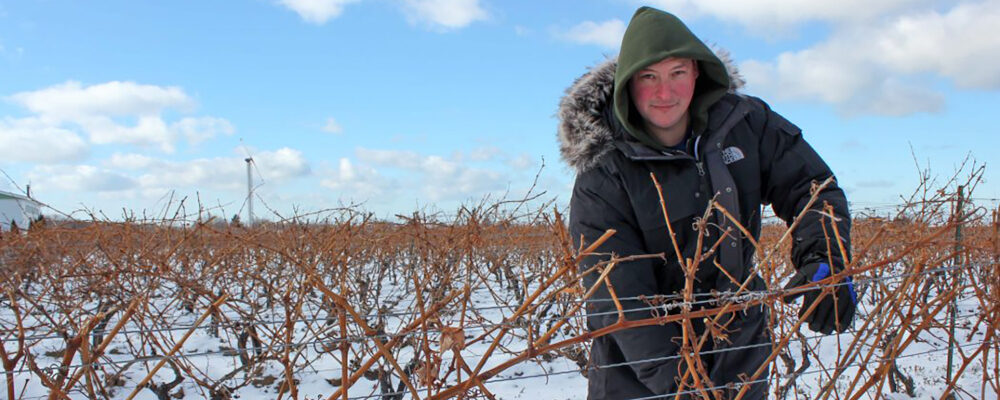Jim Willwerth is a biologist at the Cool Climate Oenology and Viticulture Institute at Brock University. He studies grape vines, and specifically the ones that grow near the institute in the Niagara Peninsula of Ontario. He has some ideas about how climate change is affecting the Canadian wine industry.
The Cool Climate Oenology and Viticulture Institute in St. Catharines, like its Western Canadian analogue, the University of British Columbia Wine Research Centre at Kelowna, was set up in the 1990s to focus Canadian research on Canadian growing conditions. Inniskillin winery founders and Canadian wine pioneers Karl Kaiser and Donald Ziraldo were leaders in its establishment.
Before CCOVI, Niagara vintners relied on research from long-established institutions like UC Davis in Northern California or L’Institut Agro Montpellier in the south of France. Three decades on, CCOVI academics like Willwerth, who is also a teaching professor of biological science, engage in both what he calls the “fundamental research of what’s going on in the vine” as well as “applied research with direct results for the Canadian wine industry.
Willwerth came to my attention recently when I was tipped off to a YouTube video of a talk he gave for the 2023 CCOVI Lecture Series. The title of the lecture is a little dry: “Improving resiliency in grapevines to avoid freeze damage in a changing climate”. But the content is interesting because it offers a well-educated guess at what Canadian wine might look like in 10, 20, or 30 years from now.
I spoke to Willwerth last week on Zoom, and he explained his expertise lies in cold climate vine hardiness. “When I was originally hired at Brock,” he explained, “my mandate was to try and improve and optimize cold hardiness in vinifera vines.” Vinifera, or fine wine, vines are thought to have originated around the Black Sea and proliferated most successfully around the Mediterranean Basin. There’s lots of work to do to see how they adapt to Canadian winters.
The problem with Willwerth’s original mandate is the problem grape growers around the world are struggling with: climate change and increasingly warm average temperatures. Willwerth realized that many of the aspects of viticulture that he was studying and monitoring in Niagara vineyards, like the selection of clones or rootstocks, were applicable to defending vines from climate change and weird weather events.
Since the shift to vinifera grapes in the Niagara wine industry in the 1970s and ’80s, a number of varieties, like Riesling, Chardonnay, Pinot Noir, Cabernet Franc, and Gamay, have established themselves as calling cards to the region. Willwerth makes a comparison with Bordeaux, where he notes consumers expect the wines to be made from the five dominant grapes, with Cabernet Sauvignon and Merlot in the leading positions.
“You don’t want to make Bordeaux with Syrah,” he jokes, making the point that replanting with warmer weather grapes isn’t a popular or viable option with producers or consumers alike. So, ways to adapt to climate change that preserve the vineyard mix as it has evolved to date, like rootstocks and clones, are of key importance. Vermentino isn’t going to replace Riesling on the Beamsville Bench.
Willwerth explained that while the EU is rushing to fund projects to research how traditionally grown grape varieties can be made to adapt to the new climate reality, it’s important that Canadian research be tailored to Canadian conditions. “We know we have a changing climate, and we know we’re going to have more extremes, so we better be ready for it,” he says.

In cool climates, the greatest threat to vinifera vines is an early thaw and spell of warm weather followed by a freeze. The danger is that the plant will come out of winter dormancy and grow buds. Those buds which would have matured into grapes will be lost with the return of cold weather, and a year of production with it.
This is where Willwerth’s work gets particularly interesting: his research on “drugs for plants”. Willwerth is studying the effects of spraying abscisic acid on vines to keep them in a state of dormancy until the beginning of a continuous growing season.
But isn’t spraying things on plants bad? I asked Willwerth if consumers should be concerned about abscisic acid. “No,” he replied, “there’s no concern at all because it’s a naturally occurring hormone in the plant, and if anything abscisic acid may have health benefits to it.” After stressing he is not a (human) health expert he referenced some research that suggested it may be beneficial in controlling diabetes.
It turns out abscisic acid might be a perfectly Canadian solution to a Canadian wine problem. Willwerth explained that the plant hormone is found in some of the highest concentrations in Maple syrup and wild blueberries.
If the Cool Climate Oenology and Viticulture Institute was founded with the idea that Canadian wine industry challenges ought to be met with Canadian-focused research, Willwerth is pleased to be in the middle of it. He said, “We have very unique conditions here,” adding, “if you can grow grapes here, you can grow grapes anywhere in the world; we have mildew pressure, cold winters, we can have drought, torrential rains during harvest, we can have everything.”
Willwerth sees a parallel between his work at CCOVI and that of the wine growers and makers he collaborates with. Just as wine itself is an expression of terroir, of the place it’s made, so is his science.




